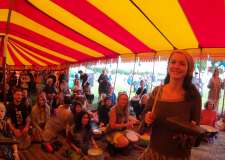Regency Society recruits National Trust chairman to help defend Brighton and Hove
The Regency Society, the oldest conservation society in Brighton and Hove, pulled off something of a coup when Sir Simon Jenkins agreed to join its ranks.
On New Year’s Day he succeeded the late Duke of Grafton as president of the society.
Sir Simon, chairman of the National Trust and England’s unofficial conservationist-in-chief, is regarded in some quarters as something of a national treasure.
He has long held Brighton and Hove in his affections. He said: “I lived in Brighton for two or three years when my parents were here when I was young. It was in the mid to late Sixties. My father was teaching at the university. I love the architecture.”
On his appointment he said: “Brighton and Hove comprises the greatest monumental townscape in Britain. It is precious and constantly in need of defenders.”
 He has a long track record of writing about and trying to preserve Britain’s architectural heritage.
He has a long track record of writing about and trying to preserve Britain’s architectural heritage.
He is a Guardian columnist and writes regular opinion pieces for the Evening Standard, which he edited in the 1970s. He was later editor of The Times.
He has written two popular and respected books on our past glories – England’s Thousand Best Churches and England’s Thousand Best Houses.
The former features St Michael and All Angels in the Clifton Hill area, not far from his Sixties home, and the vast and imposing St Bartholomew’s, just off London Road. The Royal Pavilion and Preston Manor are included in the latter.
His most recent book is A Short History of England.
He said: “I’ve always liked architecture. When I started at the Evening Standard in London I wrote about planning.”
He also learnt about some of England’s architectural glories in another early job in journalism at Country Life magazine.
While the role of president may be regarded as titular, he could well lend his name to support any big campaigns.
Not surprisingly he has strong views about the integrity of the way Brighton and Hove looks and develops.
He said: “The point about Brighton and Hove is that they’re very much of a piece. It’s not about individual buildings. It was planned. The skyline is so important.”
Are there other towns and cities – say, Bath, Oxford, Chester, York or Edinburgh – which offer lessons in how to manage the old and new, the past, present and future?
“I think on the whole Brighton and Hove is getting it right,” he said. “The integrity of the seafront has been retained apart from the Brighton Centre.”
He did not lend his support to the society when it opposed the King Alfred proposal five to six years ago. He admires Frank Gehry, the architect most associated with the controversial design.
“There was a fuss a few years ago about the King Alfred in Hove,” Sir Simon said. “But had it not been so big, that would have been an interesting addition.
“If something is too big, it’s too big. That’s the thing about the seafront terraces. They’re grand but they’re not big.”
While not expressing an opinion on the Brighton Eye – or i360 observation tower – he is clear that the West Pier should not be left to rot in the sea.
“It’s an outrageous option. It’s a totally tragic site. The West Pier was wonderful and I have many happy memories of it. There’s no reason why it can’t be rebuilt. It was a second Royal Pavilion.”
The Pavilion is pivotal to an event that looks likely to raise the Regency Society’s profile in the autumn.
The “Regency society weekend” – with a small “s” – is being organised jointly with the Royal Pavilion and Museums Foundation and the University of Brighton from Friday 12 October until Sunday 14 October.
Mary McKean, Regency Society chair, said that it would give people a chance to learn about and experience aspects of Regency life such as the food, clothing and music of the era.
She described Sir Simon as “an important national figure who would inspire the society”, adding: “We won’t have much of his time but we will have his blessing. And I’m sure I’ll find his advice invaluable from time to time.
“Sir Simon is a perfect fit for the Regency Society.
“He is an active campaigner, a participant in lively debate on key issues in conservation and the built environment and a man who engages with current issues surrounding planning not as a Nimby but with a view to protecting all that is great about Britain.”
The society campaigns for the preservation and enhancement of the historic architecture of Brighton and Hove and is often consulted about planning applications.
It also has a varied programme of trips and tours for members. Membership costs £15, or £25 for a couple. Vienna is on the horizon and another tour will take in the architecture of Charles Rennie Mackintosh in Glasgow.
The society’s lectures are popular. There is one at City College Brighton and Hove in Pelham Street, Brighton, tomorrow evening (Wednesday 11 January) about Portzed by architect Bill Dunster. And a themed quiz night on Wednesday 29 February should include some interesting images.
For more information visit www.regencysociety.co.uk.




















